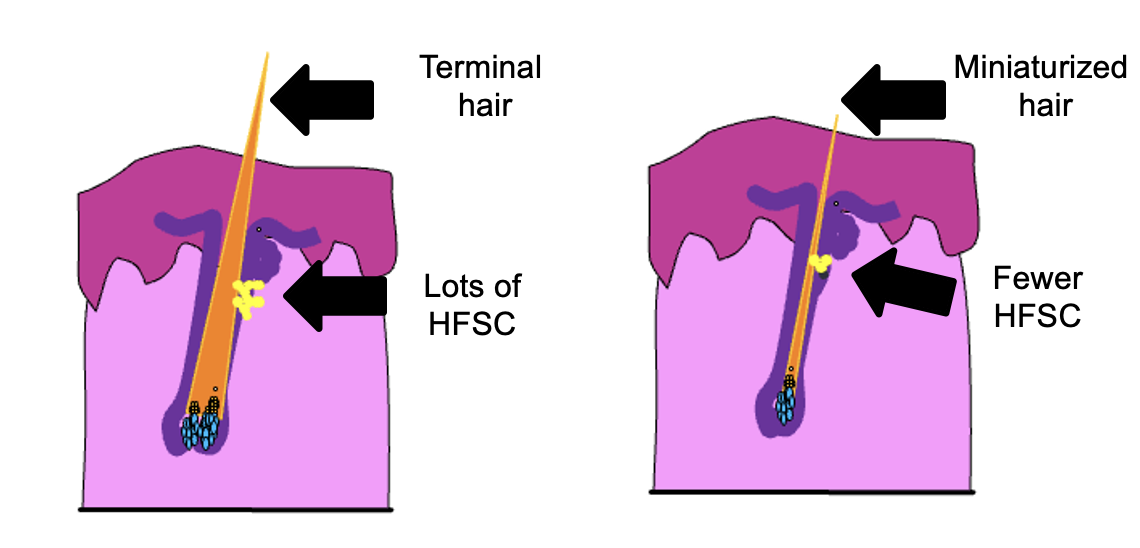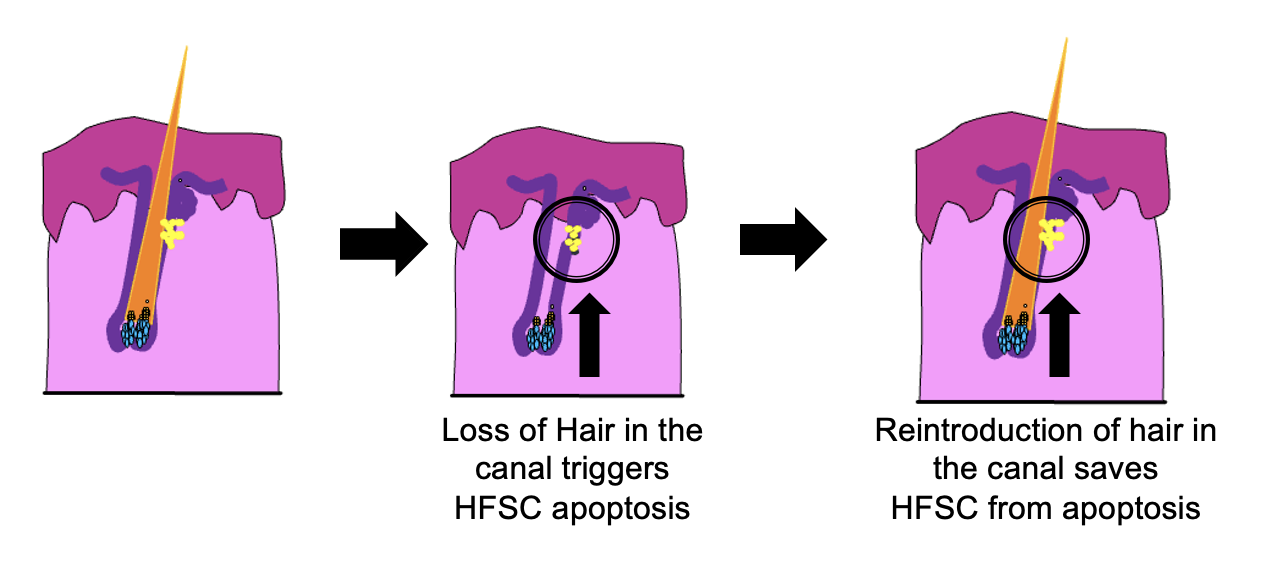An Unexpected Surprise: Hair Follicle Stem Cells (HFSCs) Like Having Thick Hairs Around
Removal or Thinning of Hairs in the Hair Canal Triggers Death of Hair Follicle Stem Cells.
A new study in the journal Cell Stem Cell, Xie et al. offers us all an unexpected finding that hair shaft thinning or loss is sufficient to reduce stem cell numbers.
Xie and colleagues showed in mice that plucked hairs triggers apoptosis of hair follicle stem cells in a manner that required calcium signalling through the Piezo1 channel and TNF alpha signalling.
Based on the study by Xie and colleagues, one wonders whether miniaturization in the course of androgenetic hair loss disrupts the stem cell niche in such a way that a proportion are triggered to undergo apoptosis.
The authors showed that plucking hair from mice triggered an increased rate of apoptosis in hair follicle stem cells (HFSC). The authors then proceeded to show that it was actually the loss of the hair fiber itself that triggered apoptosis. To show this, the authors plucked hairs, and then re-inserted them back into the hair follicles to see if the dead hair shaft itself could save stem cells from dying by apoptosis. Surprisingly, it saved hairs from apoptosis.
The authors proposed that the hair shaft serves as a “physical scaffold” for the HFSCs, and that by virtue of being in the hair canal and being thick enough to be in association with the niche helps to promote HFSC survival.
Hockc13 knockout mice show apoptosis of stem cell
The authors used an additional mouse model to show the importance of having a hair fiber in the canal. They did this using a mouse knockout model known as the Hocx13 knockout. In human, loss of Hoxc13 causes a condition called “pure hair and nail ectodermal dysplasia” which is a genetic condition in which hair follicles form, but hair is largely absent from the canal.
In the Hoxc13 knockout mouse model, the authors could show that the HFSCs in these mutant mice undergo apoptosis.
Calcium signalling triggers apoptosis.
Xie and colleagues proceed to show that plucking of hairs induced calcium signalling. They used a technique known as “intravital 2- photon calcium imaging” to show what happens to calcium signalling after hairs are plucked. In their study, HFSCs showed an increased intracellular calcium fluxes a few days after plucking. Treatment with medications that block calcium influx, could block the apoptosis of stem cells.
The Piezo1 Channel Protein is responsible for the influx of calcium
Further studies showed that the channel protein Piezo1 was responsible for helping calcium influx. Loss of of Piezeo1 protected stem cells from plucking-induced apoptosis.
Overall, the conclusion was that hair loss causes activation of calcium signalling and this leads to apoptosis of HFSCs.
TNF a is responsible for apoptosis
Further studies showed that plucking not only activates Piezo1 but also signalling through the TNF alpha receptor and together TNF alpha activation and Piezo1 activation trigger apoptosis of HFSCs. Mice with a knockout of the TNFa receptor showed that apoptosis was substantially reduced in plucked catagen HFSCs.
Conclusion
This study is important as it tells us that prolonged hair loss as well as miniaturization leads have the potential to cause a “mechanical disruption” of the stem cell niche which causes apoptosis of stem cell. Hair follicle stem cells like it when the hair canal is propped open with a full size hair follicle as it protects the stem cell niche.
Direct human studies were not done but the implication is that in AGA the miniaturization itself causes stem cells to die in addition to other independent factors that affect stem cell survival.
This fascinating study raises additional questions for me:
1) It raises the question as to whether hair follicles that are thinning are also more susceptible to stem cell apoptosis if another apoptosis trigger is introduced to the patient - like we see with chemotherapy for example. Permanent chemotherapy induced alopecia (PCIA) is a major concern among patients undergoing chemotherapy. Are patients with AGA have more likely to have permanent hair loss than those without AGA due to stem cell loss? Does the presence of a miniaturized hair in the hair follicle canal rather than a full thick hair affect the odds of developing PCIA?
I also wonder whether “plugged” hair follicles that we see in alopecia areata and discoid lupus and to some extent in AGA too could serve to “preserve” this mechanical niche by propping open the hair follicle. We see yellow dots by trichoscopy in many conditions and these are known represent hair follicles plugged with keratin material.
This study also raises the question as to whether the cosmetics industry could work to increase the thickness or fatness of hairs by other means and it by doing so this too could help protect the stem cell niche.
All in all an interesting study with some surprising findings for all of us!
REFERENCE
Xie et al.Hair shaft miniaturization causes stem cell depletion through mechanosensory signals mediated by a Piezo1-calcium-TNF-α axis. Cell Stem Cell 2022 Jan 6;29(1):70-85.e6.
This article was written by Dr. Jeff Donovan, a Canadian and US board certified dermatologist specializing exclusively in hair loss.



